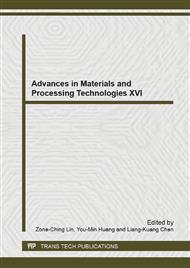[1]
Y. Guo, Z. Wang, J. Xu, G. Wang and X. Liu, Texture Evolution in a Warm-Rolled Ti-IF Steel During Cold Rolling and Annealing. Journal of Materials Engineering and Performance, 2009. 18 (4): pp.378-384.
DOI: 10.1007/s11665-008-9304-7
Google Scholar
[2]
J. Shi and D. Cui, On Optimizing Batch Annealing for the Production of IF Steels. Materials and Manufacturing Processes, 2003. 18 (1): pp.51-66.
DOI: 10.1081/amp-120017588
Google Scholar
[3]
W. C. Jeong, Strength and formability of ultra-low-carbon Ti-IF Steels. Metallurgical and Materials Transactions A, 2000. 31A: pp.1305-1307.
DOI: 10.1007/s11661-000-0125-z
Google Scholar
[4]
H. P. Ganser, E. A. Werner and F. D. Fischer, Plasticity and ductile fracture of IF steels Experiments and micromechanical modeling. International Journal of Plasticity, 1998. 14 (8): pp.789-803.
DOI: 10.1016/s0749-6419(98)00023-0
Google Scholar
[5]
J. J. Jonas, Effects of shear band formation on texture development in warm-rolled IF steels. Journal of Materials Processing Technology, 2001. 117: pp.293-299.
DOI: 10.1016/s0924-0136(01)00786-5
Google Scholar
[6]
S. Matsuoka, M. Morita, O. Furukimi and T. Obara, Effect of lubrication condition on recrystallization texture of ultra-low C sheet steel hot-rolled in ferrite region. ISIJ International, 1998. 38 (6): pp.633-639.
DOI: 10.2355/isijinternational.38.633
Google Scholar
[7]
S. H. Lee and D. N. Lee, Shear rolling and recrystallization textures of interstitial-free steel sheet. Materials Science and Engineering A, 1998. 29: pp.84-90.
DOI: 10.1016/s0921-5093(98)00588-7
Google Scholar
[8]
B. J. Duggan, Y. Y. Tse and M. Z. Quadir, Deformation and Recrystallization of Interstitial Free (IF) Steel. Materials and Manufacturing Processes, 2011. 26: pp.51-57.
DOI: 10.1080/10426910903202237
Google Scholar
[9]
M. Z. Quadir and B. J. Duggan, A microstructural study of the origins of γ recrystallization textures in 75% warm rolled IF steel. Acta Materialia, 2006. 54: pp.4337-4350.
DOI: 10.1016/j.actamat.2006.05.026
Google Scholar
[10]
R. K. Ray and A. Haldar, Texture Development in Extra Low Carbon (ELC) and Interstitial free (IF) Steels during Warm Rolling. Materials and Manufacturing Processes, 2002. 17 (5): pp.715-729.
DOI: 10.1081/amp-120016093
Google Scholar
[11]
G. H. Akbari, C.M. Sellars and J. A. Whiteman, Microstructural development during warm rolling of an IF steel. Acta Metallurgica, 1997. 45 (12): pp.155-161.
DOI: 10.1016/s1359-6454(97)00170-5
Google Scholar
[12]
P. Ghosh, C. Ghosh and R. K. Ray, Precipitation in Interstitial Free High Strength Steels. ISIJ International, 2009. 49 (7): pp.1080-1086.
DOI: 10.2355/isijinternational.49.1080
Google Scholar
[13]
S. Kim, J. Kwak, J. Chung and K. Cho, Effects of Ti on the Formability of Ti-IF Steels. Metals and Materials International, 2002. 8 (2): pp.155-161.
DOI: 10.1007/bf03027012
Google Scholar
[14]
G. Ebrahimi, S. H. Zahiri and A. Najafizadeh, Mathematical modeling of the stress-strain curves of Ti-IF steel at high temperature. Journal of Materials Processing Technology, 2006. 171: pp.301-305.
DOI: 10.1016/j.jmatprotec.2005.06.072
Google Scholar
[15]
C. Zener and J.H. Hollomon, Effect of Strain Rate Upon Plastic Flow of Steel. Journal of Applied Physics, 1944. 15 (22): pp.22-32.
DOI: 10.1063/1.1707363
Google Scholar


